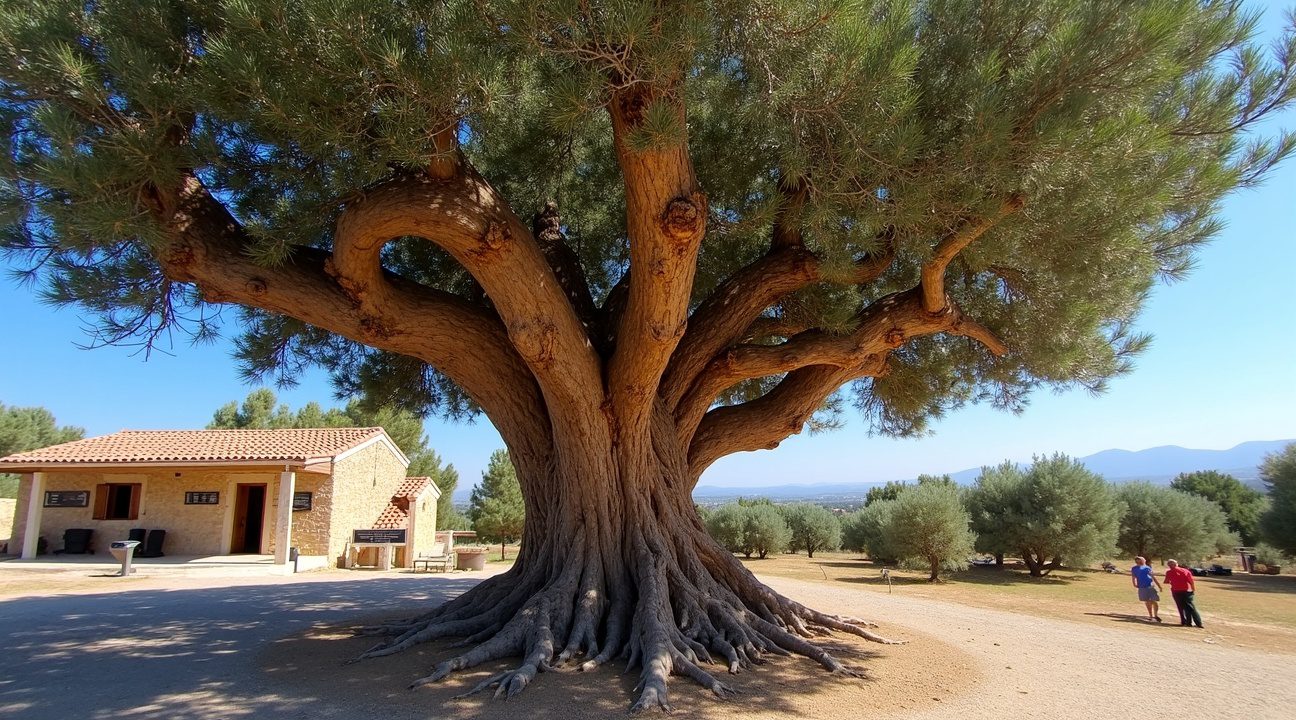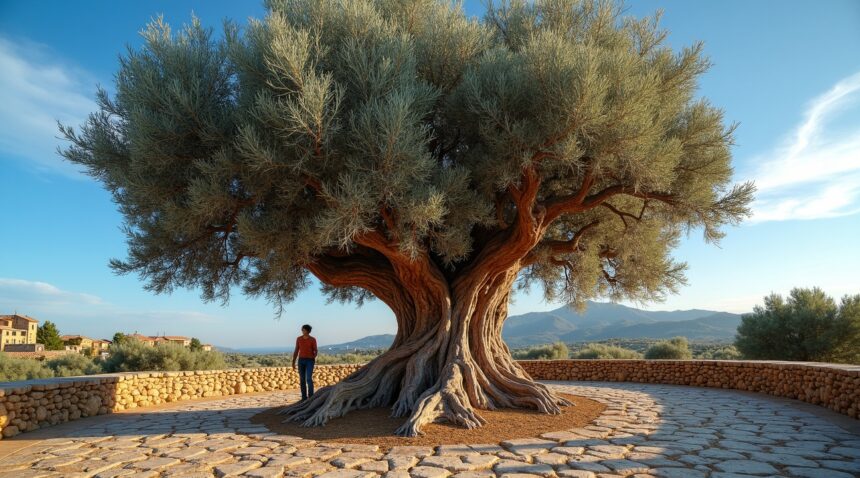Greece hosts some of nature’s most extraordinary examples of longevity and continuous productivity through its ancient olive trees, with certain specimens still bearing fruit after more than 2,000 years of growth. The Vouves olive tree on Crete stands as the most famous example, scientifically estimated between 2,000 and 4,000 years old while maintaining its annual harvest cycle and serving as a designated National Monument that connects modern Greece to its ancient agricultural heritage.
Key Takeaways
- The Vouves olive tree in Crete ranks among the world’s oldest certified olive trees, estimated at 2,000–4,000 years old, with a massive 15-foot diameter trunk and 12.5-meter circumference while still producing olives annually.
- Ancient olive trees achieve extraordinary longevity through exceptional biological adaptations including extensive root systems, drought tolerance, fire-resistant bark, and the ability to regenerate new growth from old wood even after severe damage.
- Greek olive trees held sacred status in ancient civilization, with strict legal protections, integration into Olympic victory wreaths, and deep spiritual significance that elevated them beyond mere agricultural assets to living monuments.
- Modern olive cultivation spanning 800 million trees worldwide traces back to ancient Greek farming techniques, with Mediterranean countries still dominating global production using traditional methods refined over millennia.
- These ancient specimens also provide renewable energy through biomass fuel from pruned branches and offer significant nutritional benefits through antioxidant-rich olive oil that has supported Greek cuisine and traditional medicine for thousands of years.
To learn more about the ancient Vouves olive tree, visit the Olive Tree Museum of Vouves, which offers historical insights and showcases this natural wonder firsthand.
The Vouves Olive Tree: A 4,000-Year-Old Living Monument Still Bearing Fruit
The Olive Tree of Vouves stands as one of nature’s most extraordinary testaments to longevity, rooted in the village of Ano Vouves on the Greek island of Crete. Scientific estimates place this remarkable specimen between 2,000 and 4,000 years old, making it one of the oldest certified olive trees on Earth. While local traditions claim the tree reaches 5,000 years of age, most reputable scientific studies and researchers agree on the more conservative 2,000 to 4,000-year timeframe.
This ancient giant displays physical characteristics that reflect its incredible age and endurance. The massive trunk spans 4.6 meters (15 feet) in diameter, with a circumference measuring 12.5 meters around. Despite these weathered dimensions, the Vouves olive tree continues its productive life cycle, generating olives year after year. Harvest records document fruit collection as recently as 2012, proving that this living monument maintains its agricultural purpose after millennia of continuous growth.
A Witness to Civilizations
The Vouves olive tree has silently observed the rise and fall of multiple civilizations throughout its extended lifespan. This ancient specimen has grown through the Minoan civilization, survived the classical periods of Ancient Greece, endured Roman occupation, and persisted through the Byzantine era. Each ring of growth represents decades of human history, wars, cultural shifts, and the evolution of Mediterranean society.
The tree’s cultural significance extends far beyond its agricultural value. In 1997, Greek authorities recognized its historical importance by designating the Vouves olive tree as a National Monument. This official status protects the specimen while acknowledging its role as a living piece of Greek heritage. The designation also led to the establishment of a museum at the site, where visitors can learn about olive cultivation history and ancient Greek civilization.
Olympic Recognition and Modern Significance
The Vouves olive tree achieved international recognition during the 2004 Athens Olympic Games when organizers selected branches from this ancient specimen to create victors’ wreaths. This choice connected modern Olympic achievements with Greece’s ancient agricultural heritage, honoring both contemporary athletes and the country’s historical roots. The olive wreaths served as living symbols of peace, victory, and the enduring spirit of competition that originated in ancient Greece.
Today, the Vouves olive tree continues producing fruit while serving as a powerful reminder of nature’s resilience and the deep agricultural traditions that shaped Mediterranean culture. Visitors from around the world make pilgrimages to witness this living monument that has stood for thousands of years, still bearing fruit and maintaining its connection to the land that nurtured countless generations of Greek families.

How Ancient Olive Trees Continue Producing After Millennia
I find it remarkable that certain olive trees in Greece have been bearing fruit for thousands of years, defying conventional expectations about plant lifespans. These extraordinary specimens, particularly those found on the island of Crete, represent some of the oldest living cultivated plants on Earth, with estimates placing their ages between 3,000 and 4,000 years.
The secret to their incredible longevity lies in their exceptional biological design. While most olive trees typically live between 300 and 600 years, these ancient giants have developed extensive root systems that extend far beyond what’s visible above ground. This underground network serves as the tree’s lifeline, storing nutrients and moisture that sustain the plant through countless seasons of drought and harsh Mediterranean conditions.
The Science Behind Millennial Resilience
Greek olive trees possess an extraordinary capacity for regeneration that sets them apart from other fruit-bearing species. When the main trunk suffers damage from disease, fire, or extreme weather, the robust root system continues to live and can produce new shoots and branches. This generational regeneration allows the tree to essentially rebuild itself while maintaining its ancient root foundation.
The trees’ drought tolerance proves equally impressive, as they can survive extended periods without rainfall by drawing moisture from deep soil layers. Their ability to withstand extreme cold down to -18°C makes them remarkably adaptable to varying climate conditions. Even if above-ground portions die completely, the roots remain viable and can sprout fresh growth, effectively giving these ancient specimens multiple lives within their extended existence.
This resilience explains why visitors can still observe ancient Mediterranean civilizations and their agricultural legacy through these living monuments. Each harvest from these millennia-old trees connects modern Greece directly to its agricultural ancestors, producing olives that carry genetic material unchanged for thousands of years.
The physiological adaptations that enable such longevity include:
- Specialized bark that protects against fire damage
- Leaves designed to minimize water loss
- A slow metabolism during stress periods to conserve energy
These features work together to create what amounts to biological immortality, allowing individual trees to outlast entire civilizations while continuing their productive cycles.
Sacred Trees That Shaped Ancient Greek Civilization
Olive trees held an almost mystical significance in ancient Greek society, serving as powerful symbols that connected the earthly realm with divine forces. I find it fascinating how these ancient civilizations recognized something profound about these remarkable trees—something that transcends their practical value as food producers.
The connection between olive trees and athletic achievement runs deep through Greek history. Victorious athletes in the ancient Olympic Games received wreaths crafted from olive branches, a tradition that elevated these simple leaves into symbols of human excellence and divine favor. This practice wasn’t merely ceremonial; it represented the Greeks’ belief that olive trees possessed sacred qualities worthy of honoring their greatest champions.
Ancient Greek law reflected the extraordinary reverence for these trees through strict protective measures. It was illegal to dig up or damage olive trees, even on private property, demonstrating how the state prioritized these plants above individual property rights. Such legislation highlights the trees’ status as something far beyond agricultural assets—they were living monuments deserving legal protection.
Divine Connections and Cultural Integration
The ancient Greeks viewed olive trees as sacred beings that established a direct link between earth and the divine sphere. This perspective wasn’t simply poetic metaphor; it shaped religious practices, economic policies, and cultural traditions that persisted for centuries. Olive cultivation predates written history in Greece, suggesting these trees were already deeply embedded in pre-classical civilizations.
Greek mythology reinforced the olive tree’s sacred status through various stories and legends. The trees appeared in religious rites as symbols of wisdom, peace, and divine blessing. Their integration into both spiritual and practical life created a cultural foundation that modern Greeks still honor today.
The economic importance of olives couldn’t be separated from their spiritual significance. Ancient Greek communities built entire trading networks around olive oil, yet they maintained strict reverence for the trees themselves. This balance between commercial value and sacred respect created a sustainable relationship that allowed many groves to flourish for millennia.
Modern implications of this ancient reverence extend far beyond Greece’s borders. The olive branch remains a global symbol of peace, appearing on national emblems and flags across various countries. This widespread adoption demonstrates how ancient Greek symbolism continues influencing contemporary culture and international relations.
Archaeological evidence from sites like the underwater city of Heracleion reveals how Greek trading networks spread olive cultivation and its associated cultural meanings throughout the Mediterranean. These ancient connections help explain why olive symbolism became so universally recognized.
The protective laws surrounding olive trees in ancient Greece weren’t simply environmental conservation—they represented a sophisticated understanding of cultural preservation. By protecting the trees legally, Greek society ensured that future generations would inherit both the practical benefits and spiritual significance these plants provided.
Contemporary visitors to Greece can still witness this ancient reverence in action. Many olive groves contain trees that have been producing fruit continuously for over two thousand years, their gnarled trunks bearing witness to countless generations of careful tending and protection.
The transformation of olive branches from simple plant material into Olympic wreaths illustrates how ancient Greeks elevated natural elements into powerful cultural symbols. Athletes who received these wreaths carried more than recognition for athletic prowess—they bore symbols of divine favor and cultural continuity.
Religious ceremonies in ancient Greece frequently incorporated olive oil and branches, creating tangible connections between daily agricultural practice and spiritual belief. This integration meant that tending olive trees became both economic necessity and religious duty, ensuring their careful preservation across generations.
The enduring nature of these ancient symbols speaks to something fundamental about human relationship with the natural environment. Ancient Greeks recognized that certain trees transcended their immediate utility, becoming repositories of cultural memory and spiritual significance that demanded protection and reverence.
The Remarkable Properties of the Olive Tree
Ancient olive trees possess extraordinary characteristics that have enabled them to survive and thrive for millennia across the Mediterranean landscape. These magnificent specimens combine remarkable botanical features with practical benefits that have sustained Greek communities for countless generations.
The olive tree’s natural resilience stems from its inherently rot-resistant wood, which allows these ancient giants to maintain structural integrity even as they age well beyond two thousand years. This exceptional durability comes from the wood’s dense cellular structure and natural compounds that ward off decay-causing organisms. I find it fascinating that this same resistance to deterioration contributes to the tree’s longevity while simultaneously providing practical applications for modern energy needs.
From Ancient Fruit to Modern Energy Solutions
Olive cultivation generates substantial renewable energy potential through its various byproducts. Pruned branches, leaves, and olive pits create biomass fuel that produces up to 2.5 times the heat output of standard firewood. This impressive energy efficiency makes olive waste an increasingly valuable resource for heating homes and powering facilities throughout Greece, creating a sustainable cycle that benefits both the environment and local economies.
Botanically speaking, olives belong to the drupe family, classifying them as stone fruits alongside cherries, peaches, and mangoes. This classification reflects the olive’s structure — a fleshy exterior surrounding a hard pit containing the seed. Understanding this botanical relationship helps explain why olive trees develop such robust root systems and demonstrate remarkable adaptability to harsh Mediterranean conditions.
The nutritional profile of olive fruit and oil has anchored Greek cuisine and traditional medicine for thousands of years. Extra virgin olive oil contains powerful antioxidants, including vitamin E and phenolic compounds, which contribute to cardiovascular health and inflammation reduction. These health benefits aren’t merely modern discoveries — ancient Greeks recognized olive oil’s medicinal properties and incorporated it into therapeutic practices long before scientific research confirmed its advantages.
Greek traditional medicine has utilized olive leaves, oil, and fruit in various preparations to address ailments ranging from minor wounds to digestive issues. The antimicrobial and anti-inflammatory properties found in olive compounds support these historical applications, demonstrating how ancient wisdom often aligns with contemporary scientific understanding.
Mediterranean agriculture has evolved around the olive tree’s unique growing requirements and exceptional longevity. These trees thrive in rocky, well-drained soils that might challenge other crops, making them ideal for Greece’s mountainous terrain. Their deep root systems access water sources far below the surface, allowing them to survive extended drought periods that would devastate less hardy plants.
The legendary status of Greece’s ancient olive trees, particularly the famous specimen in Vouves, Crete, faces competition from other remarkable examples across the Mediterranean. Lebanon’s “Sisters of Noah” olive trees and Israel’s “Al-Badawi” tree claim similar antiquity, creating friendly rivalry among nations proud of their olive heritage. However, the Vouves tree maintains its position as Greece’s most celebrated ancient olive, continuing to produce fruit after an estimated 2,000 to 4,000 years of growth.
Modern scientific analysis of these ancient trees reveals remarkable genetic stability and adaptation mechanisms that allow them to continue productive cycles well into their advanced age. Their ability to regenerate new growth from old wood means that even severely damaged trees can recover and resume fruit production, contributing to their legendary persistence.
The economic impact of olive cultivation extends far beyond the immediate harvest. Tourism generated by these ancient trees, particularly sites like archaeological locations with classical Greek connections, brings additional revenue to rural communities while preserving cultural heritage for future generations.
These remarkable properties — from wood durability and energy production to nutritional benefits and cultural significance — demonstrate why olive trees have remained central to Greek civilization for millennia. Their continued productivity after thousands of years represents nature’s incredible capacity for persistence and adaptation.
Global Impact of Ancient Olive Cultivation
Ancient Greek olive cultivation techniques have shaped agricultural practices across the globe for millennia. The cultivation methods developed by early Greek farmers spread throughout the Mediterranean basin and eventually reached every continent where the climate permits olive growing. By 2005, more than 800 million olive trees were planted worldwide, demonstrating the enduring legacy of this ancient agricultural tradition.
Mediterranean Dominance in Modern Olive Production
Mediterranean countries continue to dominate global olive cultivation, with Greece, Spain, and Italy leading production volumes. These nations benefit from the same climatic conditions that allowed ancient olive trees to flourish thousands of years ago. Spain produces approximately 44% of the world’s olive oil, while Italy contributes about 14%, and Greece accounts for roughly 13% of global production. The concentration of olive cultivation in these regions reflects the optimal growing conditions that Mediterranean climates provide.
Greece’s contribution extends beyond mere production numbers. The country maintains many of the original cultivation techniques that date back over two millennia. Ancient Greek methods of pruning, harvesting, and oil extraction continue to influence modern olive farming practices worldwide. Greek farmers developed sophisticated irrigation systems and terracing techniques that prevent soil erosion on hillsides, methods still employed in olive groves from California to Australia.
Ancient Cultivation Techniques in Modern Agriculture
Olive trees rank among the oldest continuously cultivated trees in human history, with some specimens in Greece still producing fruit after more than 2000 years of growth. This remarkable longevity stems from cultivation practices refined over countless generations. Ancient Greek farmers discovered that olive trees thrive with minimal intervention, developing sustainable farming methods that modern agricultural science validates.
The propagation techniques pioneered by ancient Greeks remain fundamental to olive cultivation today. Farmers worldwide still use grafting methods first developed in ancient Greece to create trees that combine desirable fruit characteristics with strong root systems. These time-tested practices ensure genetic diversity while maintaining the quality standards that have made Mediterranean olives prized globally.
Climate adaptation strategies developed by ancient Greek cultivators have enabled olive trees to spread far beyond their Mediterranean origins. Modern olive groves flourish in California, Australia, South Africa, and parts of South America, all utilizing cultivation principles established in ancient Greece. The ancient Mediterranean civilizations created agricultural foundations that continue supporting global food systems today.
Greek olive cultivation also established the economic framework for modern olive oil markets. Ancient trade routes that carried Greek olive oil throughout the known world created demand patterns that persist in contemporary international commerce. Countries that import olive oil today often trace their preferences back to ancient Greek trading relationships that introduced Mediterranean flavors to distant lands.
The environmental benefits of ancient olive cultivation practices have gained renewed appreciation in modern sustainable agriculture movements. Greek farmers developed dry-farming techniques that conserve water while maintaining tree health, methods particularly valuable in drought-prone regions. These practices demonstrate how traditional knowledge can address contemporary environmental challenges.
Modern genetic studies of olive varieties reveal that many cultivars grown worldwide originated from ancient Greek stock. The genetic diversity preserved in Greek olive groves over thousands of years provides crucial resources for developing new varieties adapted to changing climate conditions. This genetic heritage represents an invaluable contribution to global food security.
Ancient Greek olive cultivation created cultural traditions that transcend agricultural practices. Festivals celebrating olive harvests, blessing ceremonies for new groves, and communal oil-making activities have spread to olive-growing regions worldwide. These cultural elements maintain community connections to the land while preserving knowledge that ensures successful cultivation across generations.
The durability of ancient olive trees serves as living proof of sustainable agricultural practices developed over millennia. Trees planted by ancient Greeks continue producing fruit today, demonstrating that traditional cultivation methods create agricultural systems capable of supporting human communities indefinitely. This longevity offers hope for developing modern agricultural systems that can sustain future generations while honoring the wisdom embedded in ancient farming traditions.
Sources:
Delta Trees, “How many years does an olive tree, really lives?”
Queen Creek Olive Mill Blog, “9 Divine Facts About the Olive Tree”
TheTravel.com, “This 4,000-Year-Old Tree Witnessed The Rise And Fall Of One Of…”
The Norfolk Olive Tree Company Blog, “Facts about olive Trees”
LandArch Concepts, “Doorway to the Past: The Oldest Olive Trees in the World”


